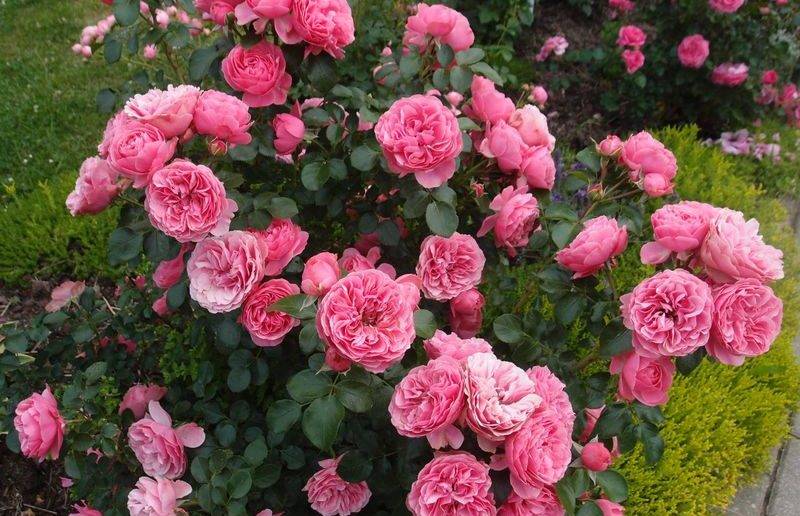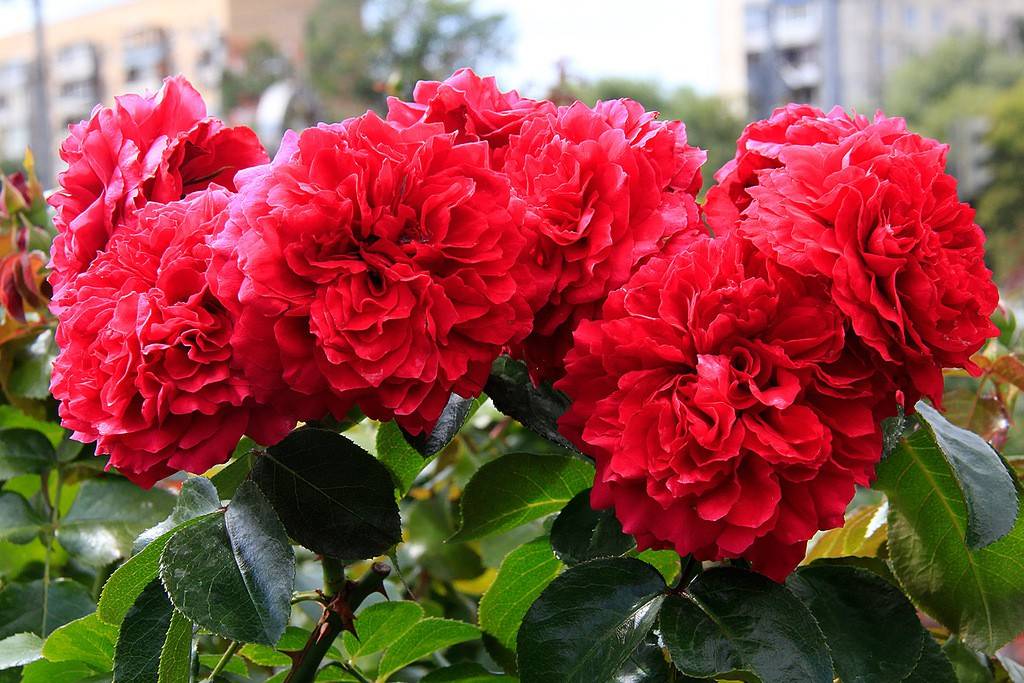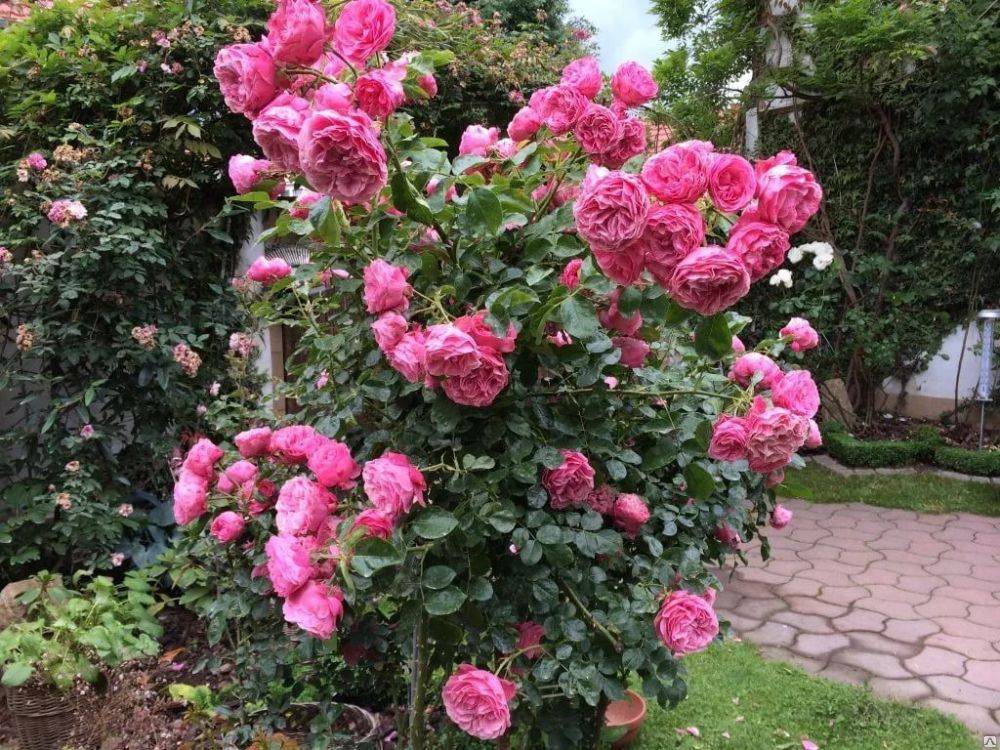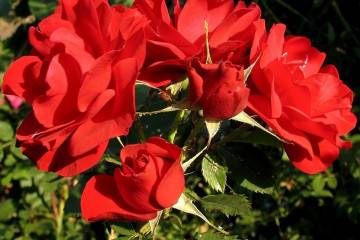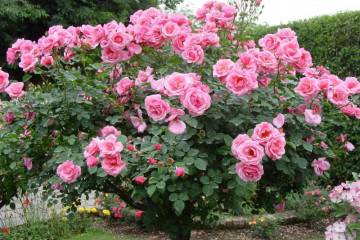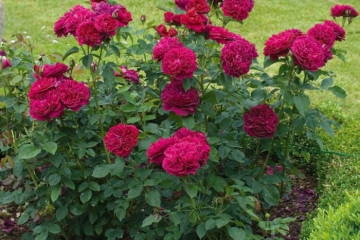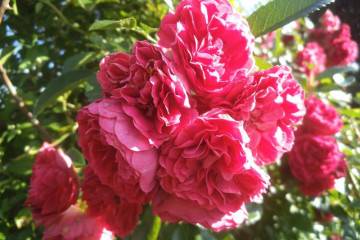Rose of Leonardo da Vinci (Leonardo de Vinci) - description of the standard variety
Content:
Rose of Leonardo da Vinci belongs to the category of roses that delight with abundant flowering throughout the season and hassle-free care. This is a very beautiful variety; to create comfortable conditions, regular watering and fertile soil are enough for it.
Rose of Leonardo da Vinci (Leonardo de Vinci or MEIdeauri) - what is this variety, the history of creation
The rose was bred in 2003 by the Meilland company. She immediately fell in love with gardeners and after so many years continues to occupy one of the leading places. The flower is the result of crossing polyanthus and hybrid tea roses and Tantau.
Brief description, characteristic
Description of the rose by Leonardo red da Vinci:
- bush height - up to 1 m;
- foliage - dense, dense, with a glossy surface, saturated green;
- buds with a diameter of about 10 cm, color - red with impurities of a pink tint;
- one peduncle consists of 4 to 6 flowers;
- aroma - light, pleasant, restrained in English.
Advantages and disadvantages of the variety
Rose Leonardo is popular for a number of benefits:
- unpretentious care;
- resistance to pests and diseases;
- lush and abundant flowering that lasts throughout the season;
- the ability to grow a rose as a bush and as a standard rose;
- frost resistance.
The disadvantages include only the scent of the flower. He is not very strong, although very pleasant.
Use in landscape design
Da Vinci rose can be planted both solo and in a group of bushes. It looks beautiful in tandem with conifers, standing out favorably against the background of their bluish branches.
Growing a flower, how to plant it in open ground
The rose is easy to plant, which can be carried out by both a novice gardener and an amateur. Planting a flower is carried out through seedlings. The seed method is not used, since the characteristics of the mother flower are not transmitted through the seeds.
Leonardo, like other floribund roses, prefers well-lit places, without drafts and strong winds. The northeast direction especially does not like the flower. It is not recommended to plant a rose in low places, where water is retained for a long time after rains or watering.
How to prepare the soil and flower for planting
The soil should be nutritious, enriched with mineral components. The earth left after digging a hole is mixed with 1 part of humus, 1 part of peat and 2 parts of sand. Bone meal and superphosphates are added to the soil.
Prepared seedlings are examined, damaged and weak roots are removed. The stems are trimmed; it is enough to leave 20 cm of their length. There must be 2-3 leaves on the branches.
Leonardo prefers loose, light soil. If the ground is heavy, drainage is needed to allow the ground to breathe and drain excess water faster. To lay the drainage, the hole is dug 20 cm deeper, expanded clay or small stone is placed on the bottom.
Planting procedure step by step
When the seedlings are prepared, planting begins:
- Well preparation - its depth should correspond to the size of the root system. The roots should fill the hole, but they should not be crowded in it. The average diameter of the hole is about 50 cm, the depth is at least 10 cm greater than the length of the root system.
- Water is poured into the hole, about 10 - 12 liters. Wait until the soil has completely absorbed the water.
- The seedling is inserted into the hole, the roots are straightened.
- The pit is filled up, the earth is slightly compacted.
- After landing, a small shaft of earth is formed, designed to retain moisture.
Plant care
Rose red Leonardo da Vinci is unpretentious, caring for it is not at all difficult, it is more likely to please every gardener.
Watering rules and humidity
Humidity is moderate. From its excess, roots can rot. Watering 1-2 times a week, depending on the weather. You need to look at the condition of the soil - as soon as the topsoil has dried, the bush needs water.
Top dressing and soil quality
Periodic fertilization and the soil enriched with mineral components promotes active growth of the bush and abundant, long flowering.
Nitrate, urea, potash fertilizers are used as fertilizers.
Pruning and replanting
The transplant is carried out in spring or autumn. When transferring to a new place, it is necessary to keep a clod of old earth around the root system. Regular pruning:
- in spring - formative pruning, strong or medium, depending on the growth of the bush;
- during the growing season - removal of dry, damaged branches;
- after each flowering - removal of wilted buds.
Features of wintering a flower
Although Leonardo is a frost-resistant rose, it needs to be wrapped up for the winter. Shoots are cut, their length should be no more than 35 cm. All leaves and buds are removed. The bush is covered with dry leaves or spruce branches. If the frosts are strong and prolonged, the rose is covered with a non-woven material.

If you do not wrap the bush, in the spring the gardener is unlikely to be pleased with the black, frozen branches of the rose.
Blooming rose
Leonardo blooms throughout the summer season: from April to September.
Care during and after flowering
During the flowering period, the rose is watered, fed once a month, alternating fertilizers. During the dormant period in autumn and early spring, before the appearance of buds, sanitary pruning is carried out.
What to do if it does not bloom, possible reasons
The rose does not bloom due to excessive watering, lack of nutrients. To establish flowering, you need to adjust the care.
Flower propagation
The rose is propagated by cuttings. The optimal time is early autumn or early spring.
Detailed description
For cuttings, young shoots are taken, at least 5 mm thick and with slight woodiness.
Procedure:
- Shoots are cut into cuttings up to 10 cm long, each should have several buds.
- Cuttings are cut - a straight cut is made above the upper kidney, above the lower one - at an angle of 45 degrees.
- The cuttings are soaked for 2 hours in a growth stimulator diluted with water.
- They are poured into a nutritious soil, watered, and covered with a film or plastic bottle on top.
The cuttings are watered periodically.
Diseases, pests and ways to control them
Leonardo is resistant to disease. Due to improper watering, roots can rot. To restore the bush, damaged roots must be removed.Aphids can attack from insects. Destroy it with soapy water or insecticides.
Leonardo is the most beautiful flower that can be found in gardens, summer cottages and winter galleries. They love it for its lush bloom throughout the summer and for its easy care.
